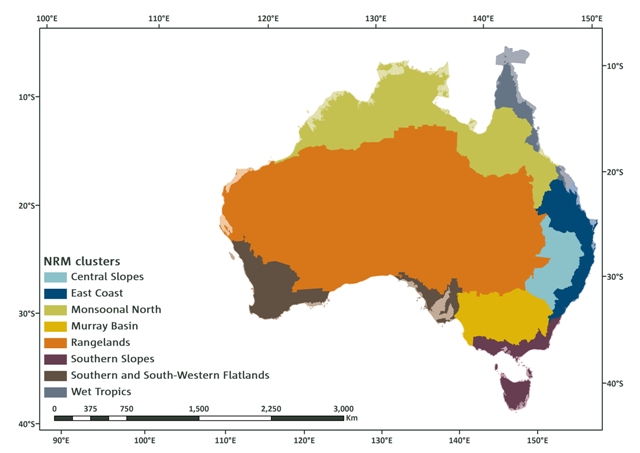Jan 27 2015
The projections are the most comprehensive ever released for Australia and have been prepared with an emphasis on informing impact assessment and planning in the natural resource management sector. Information has been drawn from simulations based on up to 40 global climate models.
 The natural resource management clusters analysed in this new study.
The natural resource management clusters analysed in this new study.
CSIRO and Bureau researchers have confirmed that most of the changes observed over recent decades will continue into the future.
“There is very high confidence* that hot days will become more frequent and hotter”, CSIRO principal research scientist, Kevin Hennessy said.
“We also have very high confidence that sea levels will rise, oceans will become more acidic, and snow depths will decline”.
“We expect that extreme rainfall events across the nation are likely to become more intense, even where annual-average rainfall is projected to decline.”
In southern mainland Australia, winter and spring rainfall is projected to decrease, but increases are projected for Tasmania in winter.
For the rest of Australia, naturally occurring fluctuations in rainfall patterns will dominate over trends due to climate change until 2030, after which the trends associated with climate change will begin to emerge.
By 2090, winter rainfall is expected to decrease in eastern Australia.
Southern and eastern Australia are projected to experience harsher fire weather, while tropical cyclones may occur less often, but become more intense.
“This research has been strongly aligned with the needs of Australia’s natural resources sector”, Mr Hennessy said. “Other researchers are using this information to assess potential impacts and management options.”
Projected changes will be superimposed on significant natural climate variability.
Observed climate information indicates that Australian average surface air temperature has increased by 0.9° C since 1910, and many heat-related records have been broken in recent years. Sea level has risen about 20 cm over the past century.
The Bureau of Meteorology has observed that since the 1970s, northern Australia has become wetter, southern Australia has become drier, the number of extreme fire weather days has increased in many places, and heavy rainfall has accounted for an increasing proportion of annual-total rainfall.
Snow depths have declined since the 1950s and cyclone frequency seems to have declined since the 1980s.
The reports can be downloaded from www.climatechangeinaustralia.gov.au.
The new climate change projections for Australia are funded by the Department of the Environment through the NRM Planning for Climate Change Fund with co-funding from CSIRO and the Bureau of Meteorology.
Learn more about long term trends in Australian climate on State of the Climate 2014 http://www.bom.gov.au/state-of-the-climate/ [external link].
* Further information on how confidence is defined can be found in Chapter 6 of the Projections for Australia’s NRM Regions Technical Report (page 88).